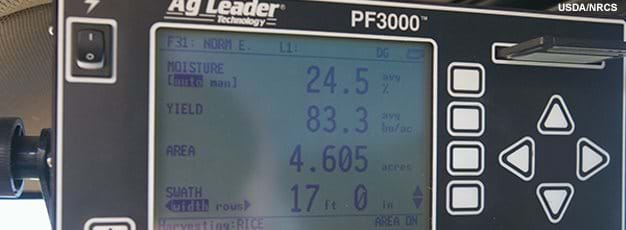The Information Age and Adoption of Precision Agriculture

Precision agriculture comprises a range of information technologies--such as yield monitors, global positioning systems (GPS), variable rate technology, and guidance systems--that farmers can use to better manage their agricultural production practices. These information technologies have the potential to reduce fuel and input expenses by enabling farmers to optimize the application of seed, fertilizer, and pesticides (see the Farms, Firms, and Households chart on the Research Areas Chart page in this issue.).
Farmers have traditionally applied fertilizer, for example, at a uniform rate that matches the highest requirement of a crop in any part of a field. But if growing conditions vary within the field, some parts of it may receive too much fertilizer, resulting in increased farm and environmental costs. Excessive or poorly timed application can contribute to nutrient runoff from farms into wells, waterways, wetlands, and estuaries. Nitrogen fertilizer, when over-applied and not incorporated into the soil, can oxidize and vaporize into a potent greenhouse gas. By enabling farmers to better match the application of fertilizers and other inputs to crop needs, precision agriculture helps mitigate these effects.
Yield monitors, the most widely used precision equipment, have been available on harvesting combines for decades but are now capable of attaching GPS location coordinates to specific yields in each part of a farmer's field. Guidance systems and auto-steering, which use GPS data to notify farm equipment operators of their exact field position, have become increasingly popular and were used on roughly 35 percent of U.S. wheat acreage in 2009.
Variable rate technologies (VRT) allow for the application of fertilizer, pesticide, and seed at different rates as the equipment moves across a field. Farmers using VRT may maximize the benefits of the technology by also using detailed field maps constructed with GPS data. These maps are not simple to create, but some farmers are combining geographic information systems with their yield and soil maps to keep track of multiple field and crop characteristics.
Despite the potential for improved production efficiency, farmers have been slow to adopt variable rate technologies, and the expected impacts on farm structure, employment, and environmental quality have not been fully realized. Research suggests that low adoption rates may be due to uncertainty about the economic returns from large initial investments in precision equipment, the complexity of these technologies, and the need to make integrated use of several precision technologies to obtain cost savings.
On the Doorstep of the Information Age: Recent Adoption of Precision Agriculture, by David Schimmelpfennig and Robert Ebel, USDA, Economic Research Service, August 2011


